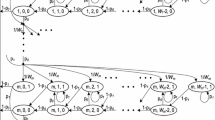Abstract
The IEEE 802.11 network technology is the emerging standard for wireless LANs and mobile networking. The fundamental access mechanism in the IEEE 802.11 MAC protocol is the Distributed Coordination Function. In this paper, we present an analytical method of estimating the saturation throughput of 802.11 wireless LAN in the assumption of ideal channel conditions. The proposed method generalizes the existing 802.11 LAN models and advances them in order to take the Seizing Effect into consideration. This real-life effect consists in the following: the station that has just completed successfully its transmission has a better chance of winning in the competition and therefore of seizing the channel than other LAN stations. The saturation throughput of 802.11 wireless LANs is investigated by the developed method. The obtained numerical results are validated by simulation and lead to the change of the existing idea of the optimal access strategy in the saturation conditions.
Similar content being viewed by others
References
A.S. Bakanov, A.I. Lyakhov and V.M. Vishnevsky, A method for evaluating performance of wireless communication networks with centralized control, Automation and Remote Control 61(4) (2000) 629–636.
G. Bianchi, Performance analysis of the IEEE 802.11 distributed coordination function, IEEE Journal on Selected Areas in Communications 18 (March 2000) 535-547.
L. Bononi, M. Conti and L. Donatiello, Design and performance evaluation of distributed contention control (DCC) mechanism for IEEE 802.11 wireless local area network, Journal of Parallel and Distributed Computing 60 (April 2000) 407-430.
F. Calì, M. Conti and E. Gregory, IEEE 802.11 wireless LAN: Capacity analysis and protocol enhancement, in: Proceedings of INFOCOM'98 (1998) pp. 142-149.
H.S. Chhaya and S. Gupta, Performance modeling of asynchronous data transfer methods of IEEE 802.11 MAC protocol, Wireless Networks 3 (March 1997) 217-234.
T.S. Ho and K.C. Chen, Performance analysis of IEEE 802.11 CSMA/ CA medium access control protocol, in: Proceedings of PIMRC'96, October 1996, pp. 407-411.
IEEE Standard 802.11, Wireless LAN Medium Access Control (MAC) and Physical Layer (PHY) specifications, IEEE Press (November 1997).
S. Saunders, P. Heywood, A. Dornan, L. Bruno and L. Allen, Wireless IP: Ready or not, here it comes, Data Communications (September 1999) 42-68.
T.J. Schriber, Simulation Using GPSS (Wiley, 1974).
J. Weinmiller, M. Schlager, A. Festag and A. Wolisz, Performance study of access control in wireless LANs - IEEE 802.11 DFWMAC and ETSI RES 10 HIPERLAN, Mobile Networks and Applications 2(1) (1997) 55–76.
Author information
Authors and Affiliations
Rights and permissions
About this article
Cite this article
Vishnevsky, V., Lyakhov, A. IEEE 802.11 Wireless LAN: Saturation Throughput Analysis with Seizing Effect Consideration. Cluster Computing 5, 133–144 (2002). https://doi.org/10.1023/A:1013977425774
Issue Date:
DOI: https://doi.org/10.1023/A:1013977425774




